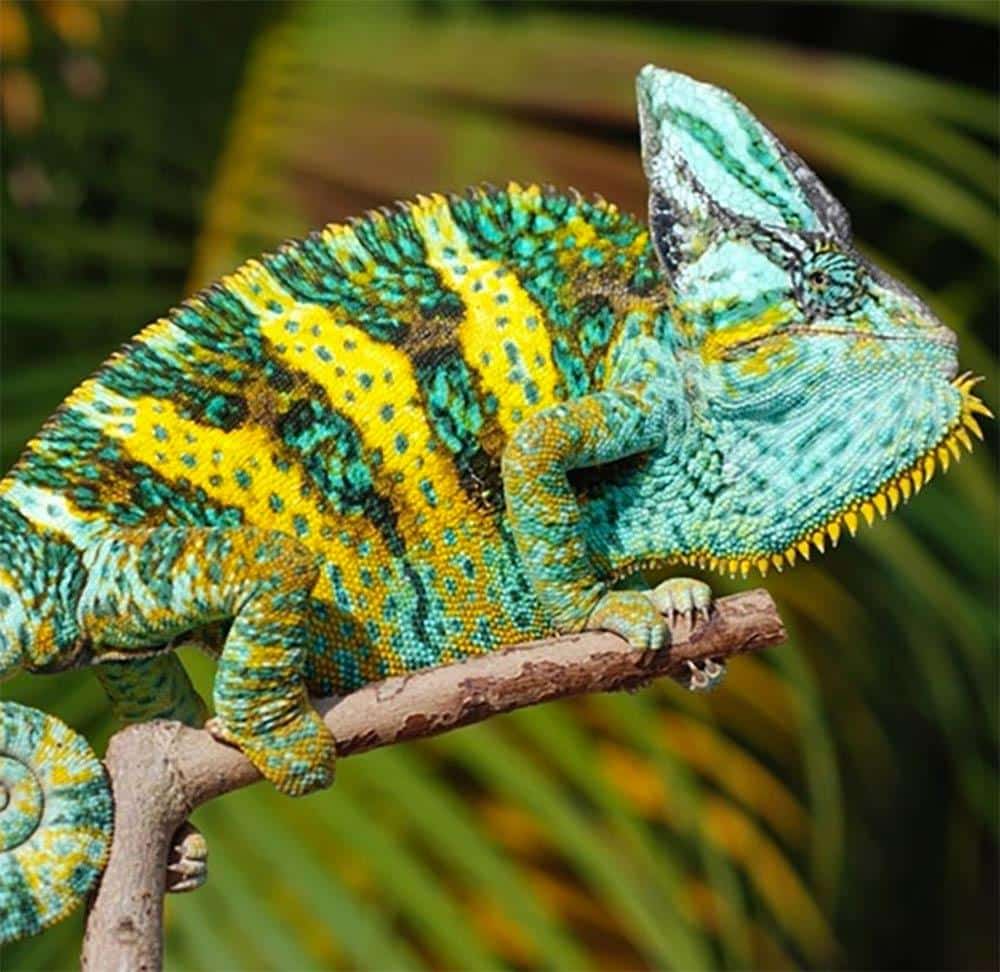Care Guide for Male & Female Veiled Chameleon Hatchlings

Male vs. Female Hatchlings: Same Roots, Different Branches

At hatch, males and females need the same core care—but soon the paths diverge. Male veileds typically show the casque (that crown) and tarsal spurs earlier, and they often push for slightly warmer basking within the safe range as they grow. Females tend to carry a quieter energy but demand careful nutrition planning long-term because of future egg production. For now, keep the hatchling care identical and excellent; sex-specific tweaks come as they size up, mon.
Hatchling Habitat Construction: A Breezy Mini-Canopy

Think “tiny rainforest balcony”—safe climbs, fresh air, and easy water access. Hatchlings dehydrate quickly and tire easily, so keep distances short and perches fine.
- Enclosure Style: Small screen or hybrid (two solid sides, others screened) works best. For group-starts, a roomy nursery like 18″×18″×24″ with heavy cover can hold several babies briefly. For singles, 12″×12″×18″ gives a cozy stage. Separate at the first sign of chasing or stress.
- Perch Network: Use thin, textured branches and bendable vines arranged in tiers. Set an easy road from basking to shade without big leaps. Zip-tie firmly so nothing wobbles.
- Live Plants: Pothos, schefflera, and ficus make water-catching leaves and hiding pockets. Rinse plants well, pot in pesticide-free soil, and cap soil with smooth stones so curious mouths don’t nibble dirt.
- Visual Barriers: Leafy “curtains” reduce line-of-sight and calm hatchling nerves. Provide multiple vantage points and safe tunnels, like little green hallways, mon.
- Drainage: Even small nurseries need runoff control. A tray, false bottom, or bulkhead to a catch bottle keeps feet dry and air clean.
Design the layout so any hatchling can find food, water, heat, and shade within a few steps. Short paths prevent fatigue and ensure they always have a comfortable microclimate to choose, bredren.
Lighting & UVB: Gentle Sun for Little Crowns

UVB fuels calcium metabolism and bone growth. Use a linear T5 HO UVB (5.0/6% class) across the top. Keep perches 8–12 inches below the lamp through screen, and create shaded “escape” lanes so babies choose their dose. Maintain a 12-hours-on/12-hours-off light cycle. Replace bulbs on schedule; the glow can look fine while UVB output fades quietly, ya know.
Temperature: Warm Up Top, Cool Down Below
Hatchlings thrive on choice. Build a gradient so each baby can move a few inches to feel better instantly.
- Basking Spot: About 82–85 °F (28–29 °C) for hatchlings—gentle sunshine, not desert sizzle. Start low and step up only if you observe persistent basking and cool body color.
- Ambient Day: 72–78 °F (22–26 °C) through the mid-levels with cooler pockets lower down.
- Night: 65–72 °F (18–22 °C) is lovely. No bright light at night; sleep is sacred, mon.
- Monitoring: One digital probe at the basking branch and one mid-level makes you the weather chief. Data loggers turn the vibes into graphs for easy tweaking.
Observe behavior: gaping, washed-out colors, or fleeing the top suggests too much heat. Dark basking and sluggish moves may ask for a mild increase. Read the body language like lyrics to the climate song.
Humidity & Misting: Morning Dew, Evening Shower
Veiled hatchlings don’t drink from bowls; they sip dew drops like forest poets. Humidity should rise and fall each day, never stewing into constant damp.
- Targets: Baseline around 50–70%, with spikes into the 70s during misting. Let it dry back down between sessions to keep lungs happy.
- Misting System: Automated misting is the heartbeat of hydration, mon. Program two to three cycles: a gentle wake-up spray (30–60 sec) to bead leaves, a longer late-day mist (2–5 min) for full drinks, and, if your ambient air is dry, a short evening rinse.
- Dripper: A slow dripper over broad leaves helps shy drinkers. Place it where babies perch naturally.
- Ventilation: Screen panels vent excess humidity while plant clusters and timed misting hold enough moisture to shine. Balance the breeze and the rain.
Check runoff management and wipe surfaces if needed. Clean water plus clean air equals irie respiration and bright eyes.
Feeding & Supplements: Tiny Bites, Big Nutrition
Fuel the growth with variety and discipline. Hatchlings burn calories like tiny flames and need frequent, appropriately sized prey.
- First Foods: Drosophila melanogaster fruit flies (then hydei), pinhead to 1/8″ crickets, small BSFL, and bean beetle larvae. Offer what they actively chase; remove leftovers to keep the nursery tidy.
- Frequency: 1–2 feedings daily in the first weeks. Place cups and free-range some feeders along common travel branches so every baby gets a fair shot.
- Gutload: Dark leafy greens, squash, sweet potato, bee pollen, and quality commercial gutloads. What nourishes the feeder nourishes the chameleon, ya know.
- Supplements: Light dusting with plain calcium most feedings; calcium with D3 and a multivitamin on a conservative schedule (e.g., every 1–2 weeks) tuned to your UVB intensity and vet guidance. More isn’t always better—aim for balance, mon.
Healthy hatchlings show strong grip, keen eyes, and steady gains. Weigh weekly if you can; numbers reveal the deeper rhythm behind the colors.
Group Care, Separation & Stress Signals

Veileds are solitary at heart. Some keepers start siblings together briefly to keep feeders close and humidity stable, but watch like a hawk. At the first sign of stress—gaping, chasing, nips, or the quiet one hanging back—separate into individual enclosures. Provide multiple feeding stations, dense plant cover, and sight breaks to diffuse tension while they share space, and be ready to give each youngster their own treehouse when the vibe turns competitive.
Special Notes as Females Mature
As females grow, plan for the long game. Balanced nutrition and careful calcium management support bone health and future reproductive wellness. Later, they’ll need a lay bin even without mating—unfertilized eggs are still a thing. For now, the hatchling program stays identical to the males—clean diet, measured supplements, UVB, and gentle temps—and you’ll raise strong queens ready for the next chapter.
Cleanliness & Daily Rhythm
Set a dependable tempo: lights on and off on schedule; misters humming at the same hours; spot cleaning daily; deep cleans as needed with reptile-safe products. Empty the drain tray before it overflows, trim plant growth to keep paths clear, and check temperatures morning and evening. Consistency is kindness, mon.
Why Lean on Experience
Raising veiled chameleon hatchlings is part science, part art, and all patience. That’s where seasoned breeders bring peace of mind. For nearly twenty years, CB Reptile has guided keepers with solid, captive-bred stock and transparent husbandry. If you’re browsing chameleons for sale, roll with folks who share lineage, care protocols, and support after the sale—because the right start plays the sweetest tune.
